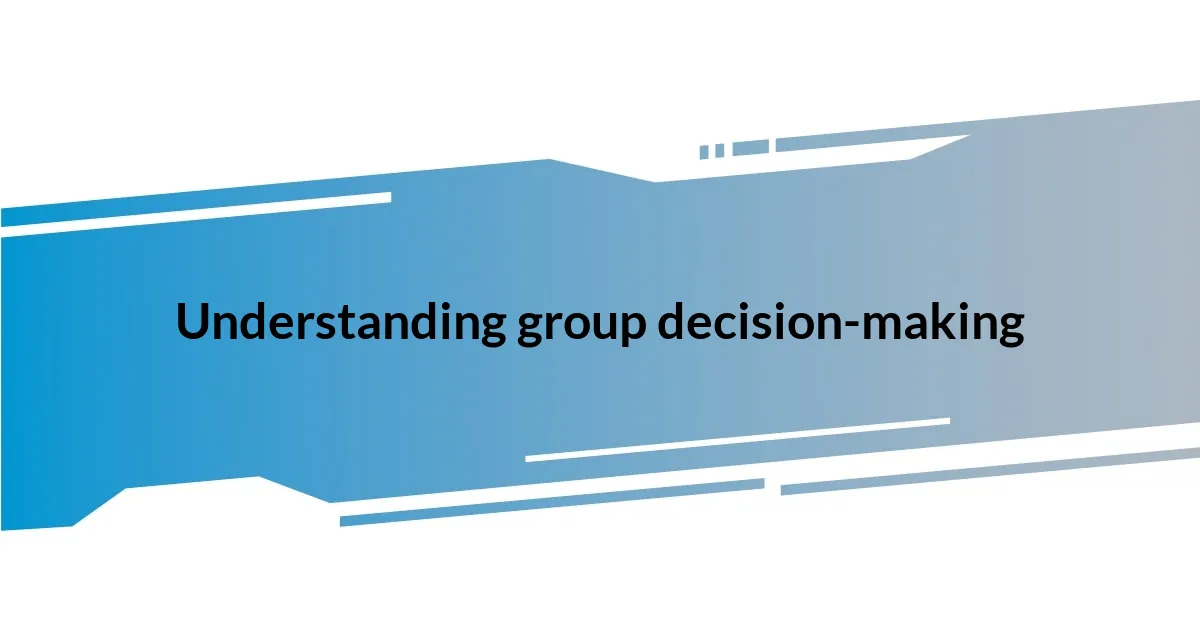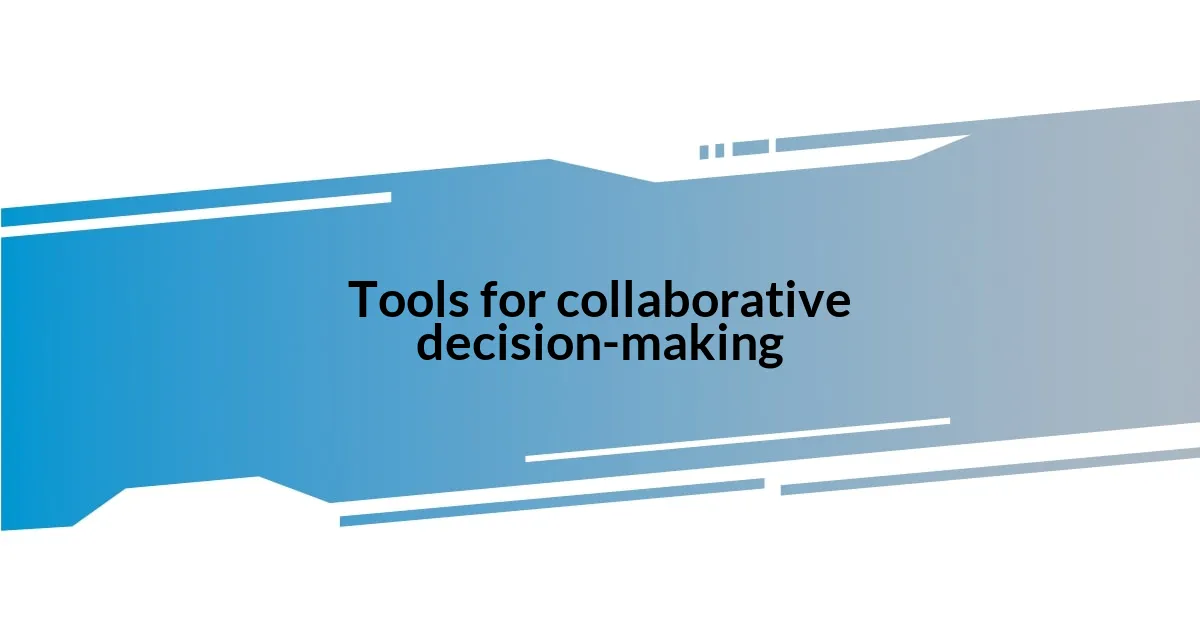Key takeaways:
- Diversity of perspectives in group decision-making fosters creativity and well-rounded solutions.
- Effective communication, including open sharing and active listening, is essential for successful outcomes.
- Establishing a culture of continuous feedback and rotating leadership roles enhances accountability and innovation.
- Utilizing collaborative tools, like decision matrices, can structure discussions and clarify decision-making processes.

Understanding group decision-making
Group decision-making can be an exhilarating yet complex process. I remember a time when our team faced a significant choice about a project direction. The room buzzed with diverse opinions, and I felt both excitement and tension—how do you untangle so many voices to find clarity?
In my experience, understanding that each member brings unique perspectives is crucial. It reminds me of a brainstorming session where one shy team member hesitantly shared an idea that turned out to be the breakthrough we needed. Have you ever witnessed a quiet voice light up the discussion? It’s a testament to how inclusive environments can elevate group dynamics.
Sometimes, the emotional weight of conflicting opinions can impact the decision outcome. I recall a time when a disagreement became tense, and I had to remind everyone of our common goal. How can we navigate these emotions effectively while still focusing on what truly matters? Embracing empathy is essential; it creates a space where every individual feels valued and heard, ultimately leading to better decisions.

Benefits of group decision-making
The benefits of group decision-making are profound and often surprising. In my experience, tapping into the collective wisdom of a group can yield more creative solutions than going it alone. I remember a project where my colleagues and I bounced ideas around—what started as a vague concept soon transformed into a detailed plan thanks to everyone’s input. That collaborative energy not only enhanced our final decision but also strengthened our bond as a team.
Here are some key benefits I’ve noticed in group decision-making:
- Diversity of Perspectives: Bringing together different viewpoints leads to well-rounded decisions.
- Enhanced Creativity: Group brainstorming often sparks innovative ideas that individual thinkers might miss.
- Shared Responsibility: When everyone participates, the weight of the decision is lighter, reducing individual stress.
- Increased Commitment: Involving team members in the process fosters a sense of ownership and accountability for the outcome.
- Better Problem Solving: Diverse skills and experiences can tackle challenges from multiple angles for optimal solutions.

Effective communication in groups
Effective communication is the lifeblood of successful group decision-making. I’ve found that when team members can openly share their thoughts, it fosters trust and encourages participation. A memorable instance was during a project where we implemented a “round-robin” sharing method, allowing everyone to speak without interruptions. It transformed the conversation, making everyone feel valued and amplifying those quieter voices we sometimes overlook.
In my experience, clarity is also key. I remember a challenging meeting where discussions became convoluted, leading to frustration. It wasn’t until we used a whiteboard to visualize our ideas that everything fell into place. By articulating our thoughts in a shared space, we uncovered hidden connections that ultimately drove our decision-making process forward.
Listening is just as vital as speaking. I often reflect on a team meeting where, despite strong opinions, one colleague’s careful observations went unnoticed. Taking a moment to ask for feedback from everyone created a more cohesive environment where those insights could shine through. This attention to active listening not only promotes effective communication but enriches the decision-making process, helping everyone to feel heard and engaged.
| Aspect | Importance |
|---|---|
| Open Communication | Encourages trust and participation |
| Clarity in Expression | Facilitates understanding and connection |
| Active Listening | Ensures diverse inputs are valued |

Techniques for facilitating discussions
One technique I’ve found particularly effective in facilitating discussions is using brainstorming sessions. I recall a time when we gathered around a whiteboard and set a timer for 15 minutes to jot down every idea that came to mind—no matter how wild. The energy in the room was contagious, and surprisingly, some of the most unconventional ideas sparked meaningful conversations that led us to a truly innovative solution. Have you ever noticed how a little pressure can really ignite creativity?
Another valuable method is the use of facilitation tools, like sticky notes or digital platforms. I remember leading a virtual meeting where we used an online sticky note app to gather input on a pressing issue. Each person contributed their ideas anonymously, which removed any fear of judgment and encouraged more honest participation. This simple change in approach opened the floodgates to insights I never would have anticipated. It’s fascinating how changing the format can completely shift the dynamics of discussion, don’t you think?
Finally, establishing ground rules for the discussion can make a world of difference. I once joined a team that agreed on a “no interrupting” rule, which revolutionized our conversations. It fostered a sense of respect and allowed each voice to be heard without anxiety about being cut off. Creating an environment where team members feel safe to express themselves can lead to richer discussions and ultimately better decisions. How do you think your team would respond to a simple rule like that?

Tools for collaborative decision-making
Using collaborative tools can significantly enhance group decision-making. I’ve often relied on digital platforms, such as Google Docs or Miro, to facilitate real-time collaboration. The last time I used Miro, I was amazed at how quickly my team generated ideas while visualizing our thought processes on a virtual board. It was as if the walls of our meeting room faded, allowing creativity to flow freely, which made everyone feel like they were part of the action.
Another gem I’ve discovered is collaborative rating systems. I remember a project where we had to prioritize features for a product. We employed a simple voting system where each team member could score their top choices. Watching the number of stars accumulate next to certain features sparked engaging discussions that revealed the group’s true priorities. Isn’t it interesting how the power of collective input can steer decisions in a way that feels democratic and fair?
Don’t overlook the value of decision matrices. One memorable situation involved a complex choice about which marketing strategy to pursue. By mapping out the potential impact and feasibility of each option in a matrix format, we clarified our thinking and gained consensus faster than I expected. The whole team felt more aligned, and I was reminded that sometimes a structured approach is exactly what’s needed to illuminate the path forward. Have you ever tried using a decision matrix in your discussions? It might just change the way you engage with complex choices.

Evaluating group decisions
Evaluating group decisions often feels like walking a tightrope. I still remember a time when our team decision didn’t yield the expected results. We held a retrospective discussion where everyone expressed their thoughts on what went wrong. The vulnerability everyone showed helped uncover blind spots we hadn’t noticed during the original decision-making process. Isn’t it intriguing how reflecting on our choices can actually lead to growth?
When it comes to evaluating decisions, tracking outcomes is vital. I’ve found creating a set of metrics beforehand to gauge success can be incredibly insightful. During one project, we decided to measure our progress based on specific KPIs—key performance indicators—like customer feedback and engagement levels. Having those benchmarks made it easier to assess whether our decision was on target. It truly emphasized the connection between thoughtful evaluation and continued improvement.
A common pitfall I’ve observed in group evaluations is the tendency to dwell on blame. In my experience, it’s more productive to focus on lessons learned instead of finger-pointing. I recall a project that flopped, and instead of assigning blame, we dedicated time to discuss what we could do differently next time. This shift in mindset transformed our evaluations into valuable team-building exercises. After all, wouldn’t you rather foster a culture of growth over one of regret?

Improving future group outcomes
One powerful way to improve future group outcomes is to establish a culture of continuous feedback. I remember a project where we set up a short feedback loop after each meeting. By encouraging everyone to share their thoughts on what worked and what didn’t, we made adjustments in real-time. This not only enhanced our decision-making but also fostered a sense of ownership and accountability among team members. Have you considered how feedback can be a tool for transformation in your group interactions?
Another pivotal strategy is to rotate leadership roles during decision-making processes. I’ve seen remarkable benefits when different team members take the reins, as it brings fresh perspectives and ideas. During one project, a quieter team member stepped up to lead a brainstorming session. Their unique approach shifted the discussion, sparking creativity that might not have surfaced under our usual leader. Isn’t it fascinating how varying leadership can unlock hidden potential in your team?
Lastly, integrating a follow-up system can greatly enhance accountability and motivation. I’ve learned that when we set clear responsibilities after a decision is made, it clarifies expectations and drives commitment. In one instance, we assigned tasks and followed up a week later to see progress. This simple act of checking in not only kept us all on track but also reinforced a collective commitment to our goals. What steps are you taking to ensure that decisions don’t just fade away after the conversation ends?